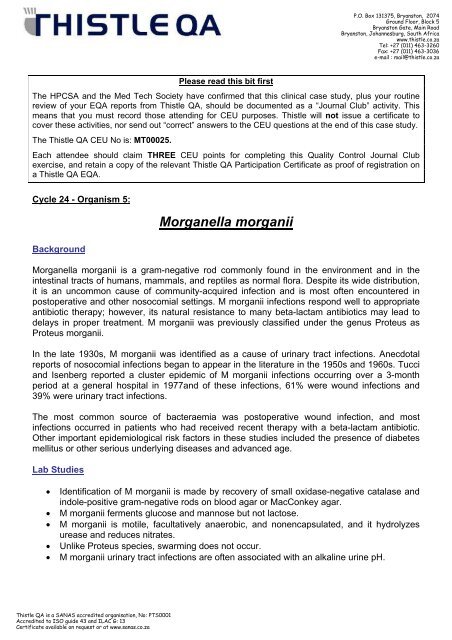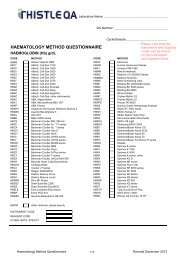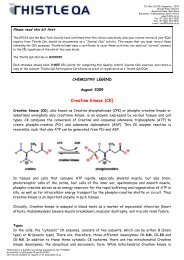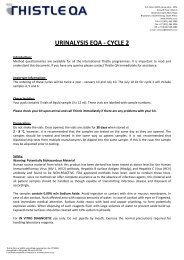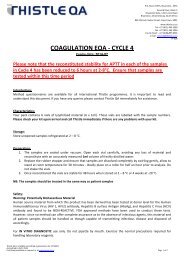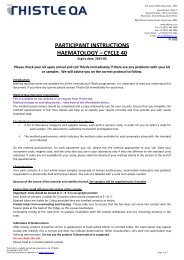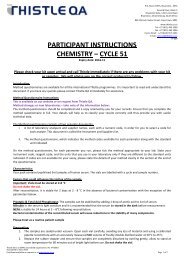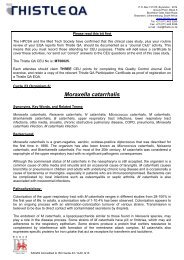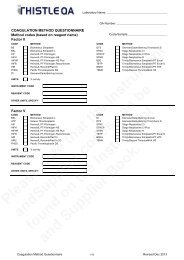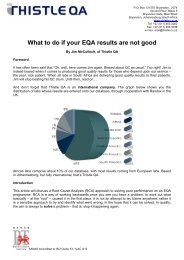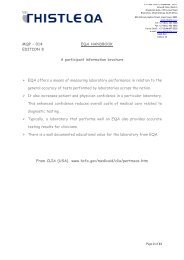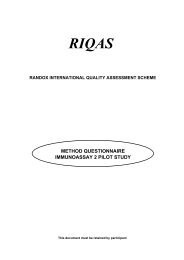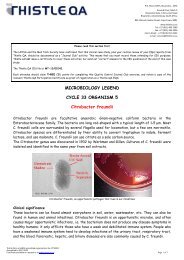Morganella morganii - Thistle QA
Morganella morganii - Thistle QA
Morganella morganii - Thistle QA
Create successful ePaper yourself
Turn your PDF publications into a flip-book with our unique Google optimized e-Paper software.
P.O. Box 131375, Bryanston, 2074<br />
Ground Floor, Block 5<br />
Bryanston Gate, Main Road<br />
Bryanston, Johannesburg, South Africa<br />
www.thistle.co.za<br />
Tel: +27 (011) 463-3260<br />
Fax: +27 (011) 463-3036<br />
e-mail : mail@thistle.co.za<br />
Please read this bit first<br />
The HPCSA and the Med Tech Society have confirmed that this clinical case study, plus your routine<br />
review of your E<strong>QA</strong> reports from <strong>Thistle</strong> <strong>QA</strong>, should be documented as a “Journal Club” activity. This<br />
means that you must record those attending for CEU purposes. <strong>Thistle</strong> will not issue a certificate to<br />
cover these activities, nor send out “correct” answers to the CEU questions at the end of this case study.<br />
The <strong>Thistle</strong> <strong>QA</strong> CEU No is: MT00025.<br />
Each attendee should claim THREE CEU points for completing this Quality Control Journal Club<br />
exercise, and retain a copy of the relevant <strong>Thistle</strong> <strong>QA</strong> Participation Certificate as proof of registration on<br />
a <strong>Thistle</strong> <strong>QA</strong> E<strong>QA</strong>.<br />
Cycle 24 - Organism 5:<br />
Background<br />
<strong>Morganella</strong> <strong>morganii</strong><br />
<strong>Morganella</strong> <strong>morganii</strong> is a gram-negative rod commonly found in the environment and in the<br />
intestinal tracts of humans, mammals, and reptiles as normal flora. Despite its wide distribution,<br />
it is an uncommon cause of community-acquired infection and is most often encountered in<br />
postoperative and other nosocomial settings. M <strong>morganii</strong> infections respond well to appropriate<br />
antibiotic therapy; however, its natural resistance to many beta-lactam antibiotics may lead to<br />
delays in proper treatment. M <strong>morganii</strong> was previously classified under the genus Proteus as<br />
Proteus <strong>morganii</strong>.<br />
In the late 1930s, M <strong>morganii</strong> was identified as a cause of urinary tract infections. Anecdotal<br />
reports of nosocomial infections began to appear in the literature in the 1950s and 1960s. Tucci<br />
and Isenberg reported a cluster epidemic of M <strong>morganii</strong> infections occurring over a 3-month<br />
period at a general hospital in 1977and of these infections, 61% were wound infections and<br />
39% were urinary tract infections.<br />
The most common source of bacteraemia was postoperative wound infection, and most<br />
infections occurred in patients who had received recent therapy with a beta-lactam antibiotic.<br />
Other important epidemiological risk factors in these studies included the presence of diabetes<br />
mellitus or other serious underlying diseases and advanced age.<br />
Lab Studies<br />
• Identification of M <strong>morganii</strong> is made by recovery of small oxidase-negative catalase and<br />
indole-positive gram-negative rods on blood agar or MacConkey agar.<br />
• M <strong>morganii</strong> ferments glucose and mannose but not lactose.<br />
• M <strong>morganii</strong> is motile, facultatively anaerobic, and nonencapsulated, and it hydrolyzes<br />
urease and reduces nitrates.<br />
• Unlike Proteus species, swarming does not occur.<br />
• M <strong>morganii</strong> urinary tract infections are often associated with an alkaline urine pH.<br />
<strong>Thistle</strong> <strong>QA</strong> is a SANAS accredited organisation, No: PTS0001<br />
Accredited to ISO guide 43 and ILAC G: 13<br />
Certificate available on request or at www.sanas.co.za
P.O. Box 131375, Bryanston, 2074<br />
Ground Floor, Block 5<br />
Bryanston Gate, Main Road<br />
Bryanston, Johannesburg, South Africa<br />
www.thistle.co.za<br />
Tel: +27 (011) 463-3260<br />
Fax: +27 (011) 463-3036<br />
e-mail : mail@thistle.co.za<br />
A recent UK health study found that there was a 4.1% increase (Figure 1) in the total reports of<br />
Proteus spp., M. <strong>morganii</strong>, and Providencia spp. bacteraemia reported via the voluntary<br />
surveillance scheme in 2007 (2709 reports), compared to 2003 (2602 reports). This increase<br />
was far lower than the 24% increase in reports for all bacteraemia (85,354 to 105,928).<br />
Figure 1:<br />
Proteus spp., <strong>Morganella</strong> <strong>morganii</strong>, and Providencia spp. bacteraemia reports (England, Wales and<br />
Northern Ireland): 2003 to 2007*<br />
The number of laboratories voluntarily reporting data for Proteus spp., M. <strong>morganii</strong>, and<br />
Providencia spp. bacteraemia decreased marginally from 196 in 2003 to 184 in 2007. However,<br />
the percentage of laboratories identifying Proteus spp., M. <strong>morganii</strong>, and Providencia spp.<br />
isolates to species level increased from 98% in 2003 to 99% in 2007 while the percentage<br />
reporting drug susceptibility data increased from 81% in 2003 to 92% in 2007.<br />
CPD Questions:<br />
1. What factors increase the risk factor for bacteraemia with M. Morganii?<br />
2. Using Figure 1, would you say that bacteraemia with M. Morganii is a significant risk?<br />
3. What percentage of Gram negative bacilli isolated in your own laboratory are M.<br />
Morganii?<br />
<strong>Thistle</strong> <strong>QA</strong> is a SANAS accredited organisation, No: PTS0001<br />
Accredited to ISO guide 43 and ILAC G: 13<br />
Certificate available on request or at www.sanas.co.za


